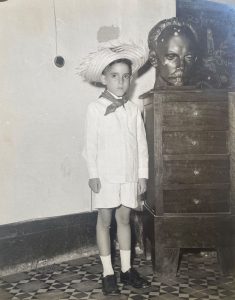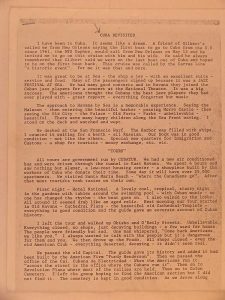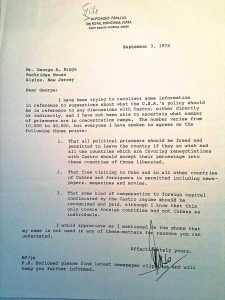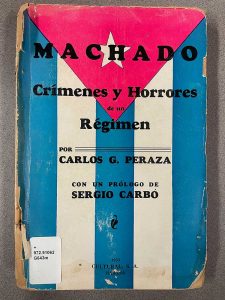Welcome to a treasure box of digitized documents, objects and imagery from UF’s Cuban archives at Smathers Libraries’ Special Collections! Here we present archival materials that span different periods of Cuban history and are also unknown to most historians and the public alike. We hope to inspire their use in classrooms around the world and to further knowledge of the rich political culture of Cuba. Gems of the Archive will itself become an archive as new examples are uploaded monthly.
All items curated by Lillian Guerra with the assistance of Miguel Torres Yunda.
- “Terpsichore” by Manuel López Oliva (1997)
 Read more
Read moreOne of the nine muses in the religion of the ancient Greeks, Terpsichore is primarily known as the patron of dance.
- “Free and Equal”: Really?
 Read more
Read moreFor much of its first three decades in power, the Cuban government spent an astonishing amount of money, time, and effort courting the white American and Western European “Left”, particularly through its Soviet-modelled Instituto Cubano de Amistad con los Pueblos , originally founded in the early 1940s by Stalinist leaders of the Partido Socialista Popular, a label Cuban Communists adopted until 1965.
- Cuban Patriot Day, 1958
 Read more
Read moreSince the 1920s, Cubans have celebrated as a national holiday the birthday of José Martí, the nationalist writer and principal civilian leader of Cuba’s 1895 War for Independence from Spain.
- What a passport can say
 Read more
Read moreIn 1963, my father, Tomás H. Guerra, decided to leave Cuba for exile after the government passed communist reforms that eliminated his peasant family’s right to grow and sell crops independently of the state.
- The Liberty Editions of 1959
 Read more
Read moreBefore Fidel Castro’s government took over the press in the early summer of 1960, Bohemia magazine had a vast circulation among subscribers across the island and large swaths of Latin America.
- Quinceañera Glamour Shots of the 1970s
 Read more
Read moreIn 1968, Fidel Castro unexpectedly announced the confiscation of all remaining small businesses on the island without compensation to their owners.
- Witnessing Cuba in the 1970s
 Read more
Read moreProbably written in 1978 when the Carter administration negotiated with the Castro regime to allow visits by Cuban exiles and US citizens for the first time, this fascinating report paints a portrait not unlike that of Cuba today.
- Sugar magnate (privately) endorses US-Cuba relations
 Read more
Read moreDated 1974, this letter from Cuban sugar baron Alfonso Fanjul to his cousin and fellow magnate George Braga reveals the tight connection between US foreign policy toward Cuba and the power of the United States’ wealthiest elite.
Read more "Sugar magnate (privately) endorses US-Cuba relations"
- “This is your house, Fidel” (1959):
 Read more
Read moreThroughout 1959, the revolutionary government headed by Fidel Castro and a cabinet of top revolutionaries who had fought the urban war against Batista was enormously popular.
- Revolutionary Drinking Glass (1959):
 Read more
Read moreThis glass is a product of the massive tide of euphoria that engulfed popular culture and consciousness when Fidel Castro’s caravan triumphantly entered Havana on January 8, 1959, a week after the dictator Batista had fled.
- Machado: Crímenes y horrores de un regimen by Sergio Carbó (1933):
 Read more
Read moreOwner and director of the newspaper Prensa Libre, journalist Sergio Carbó completed this book, the first record of the atrocities perpetrated by President Gerardo Machado’s government against citizens, in late August 1933. It was published only two weeks after the dictator, his family and many military and police officials fled Cuba for sanctuary in Miami.
Read more "Machado: Crímenes y horrores de un regimen by Sergio Carbó (1933):"
- Medal for building “tunnels of love” or war? Fidel’s autocracy in the 1980s
 Read more
Read moreIn the wake of the Soviet Union’s collapse, many of the most far-fetched examples of Fidel Castro’s “policy-making-by-whim” became both the stuff of legend and taboo.
Read more "Medal for building “tunnels of love” or war? Fidel’s autocracy in the 1980s"
- Cuban Cigarette Cards of Erotica
 Read more
Read moreMost of us know that bubble gum companies once included collectible baseball cards in their packages in order to encourage sales. But did you know that Cuban cigarette manufacturers did something similar over a century ago?
- Fidel Castro in Moscow’s Red Square, 1963
 Read more
Read moreTaken by Alberto Díaz, better known as “Korda”, and bearing the stamp of his studio, this photograph shows a 36-year-old Fidel Castro addressing adoring crowds in Moscow on his April 1963 tour of the Soviet Union. Although conspicuously absent from the stage that day,
- Recycled Beer Cans (2011)
 Read more
Read moreAlthough most of us would probably not qualify these objects as “archival”, a historian sees in them the opportunity to document the struggles that Cubans face in an economy defined by austerity, scarcity and intense creativity.
- Recycled toothpaste tubes and pull-off tops (2016)
 Read more
Read moreIn 2016, Historian of the City of Baracoa, Dr. Alejandro Hartmann, took me on a whirlwind tour of chocolate farmers and “manufacturers” of artisanal chocolates in the mountains near the city.
Read more "Recycled toothpaste tubes and pull-off tops (2016)"
- “Welcome to Our Revolution” (1959)
 Read more
Read moreThis pamphlet dates from the winter of 1959 when Nancy Macaulay first visited her husband Neill Macaulay in Cuba.
- Alma Guajira
 Read more
Read moreThis original copy of the play “Peasant Soul” (Alma Guajira) was published by the Cuban cigar company Gener in 1927.
- A Communist Life in Medals
 Read more
Read moreIn Cuba, like the Soviet Union, the practice of distributing small lapel pins as tokens of the state’s political appreciation became and remained fundamental.
- Cigar Label
 Read more
Read moreHow a cigar label revealed the hypocrisy of many pro-Embargo American politicians.